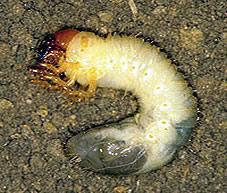Ten-lined June beetle of the scarab beetles family is primarily identified by the ten white prominent lines on their wing covers, which also results in their name. These beetles are indigenous to the western parts of the United States as well as Canada.
Size: 38.1 mm (1.5 inches)
Color: They have a brownish-black body, with four long and a short stripe located on each col3 of their wing covers or elytra. The bottom part of their thorax has brown hairs.
Other Characteristic Features: Both the sexes appear large. The males have bigger antennae than their female counterparts with many plate-like structures.
The larva has a white body and brown head. They grow to about 50.8 mm (2 inches).

The larval stage goes through three instars, after which, in the following spring, they transition into the pupal phase.
The eggs have a creamy, oval appearance, growing to 27 mm (1.06 inches) long.
| Other Names | Watermelon beetle, hissing beetle |
| Adult lifespan | Not recorded |
| Duration of larval stage | 4 years |
| Distribution | Western United States, Canada |
| Habitat | Orchards, garden |
| Common Predators | Birds, and toads |
| Seasons active from | March – July |
| Host Plants | Strawberry, potato, rose, corn, cane fruit, poplar, willow |
| Diet of larvae and adults | Larvae: Roots Adults: Foliage |
The larva damages the roots while the adults feed on the leaves, weakening the plants, even causing them to die.
However, the ten-lined June beetle does not bite or cause any physical harm to humans.
Image Source: inaturalist-open-data.s3.amazonaws.com, birdspiders.com, bugguide.net, i.pinimg.com
Ten-lined June beetle of the scarab beetles family is primarily identified by the ten white prominent lines on their wing covers, which also results in their name. These beetles are indigenous to the western parts of the United States as well as Canada.
Size: 38.1 mm (1.5 inches)
Color: They have a brownish-black body, with four long and a short stripe located on each col3 of their wing covers or elytra. The bottom part of their thorax has brown hairs.
Other Characteristic Features: Both the sexes appear large. The males have bigger antennae than their female counterparts with many plate-like structures.
The larva has a white body and brown head. They grow to about 50.8 mm (2 inches).

The larval stage goes through three instars, after which, in the following spring, they transition into the pupal phase.
The eggs have a creamy, oval appearance, growing to 27 mm (1.06 inches) long.
| Other Names | Watermelon beetle, hissing beetle |
| Adult lifespan | Not recorded |
| Duration of larval stage | 4 years |
| Distribution | Western United States, Canada |
| Habitat | Orchards, garden |
| Common Predators | Birds, and toads |
| Seasons active from | March – July |
| Host Plants | Strawberry, potato, rose, corn, cane fruit, poplar, willow |
| Diet of larvae and adults | Larvae: Roots Adults: Foliage |
The larva damages the roots while the adults feed on the leaves, weakening the plants, even causing them to die.
However, the ten-lined June beetle does not bite or cause any physical harm to humans.
Image Source: inaturalist-open-data.s3.amazonaws.com, birdspiders.com, bugguide.net, i.pinimg.com